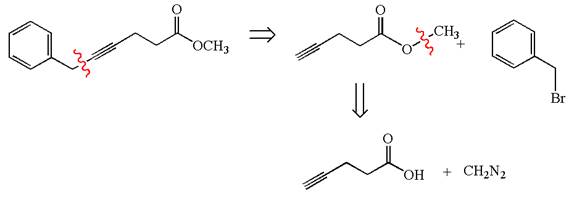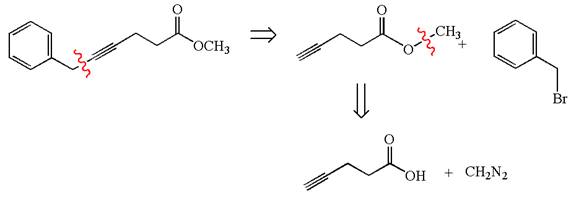
(a)
Interpretation:
It is to be shown how a retrosynthetic analysis might be constructed for the given synthesis.
Concept introduction:
Retrosynthesis is the planning of
Answer to Problem 13.30P
The retrosynthesis for the given synthesis is

Explanation of Solution
The given synthetic reaction is

In the given synthesis, the product differs from the starting compound by one ethyl group bonded to six-membered ring. Thus, the bond between the ethyl group and ring carbon in the target must break to transform it to the starting compound.
Therefore, retrosynthesis for the given synthetic reaction is

The retrosynthesis for the given synthetic reaction is shown by disconnecting the ethyl group from the ring.
(b)
Interpretation:
It is to be shown how a retrosynthetic analysis might be constructed for the given synthesis.
Concept introduction:
Retrosynthesis is the planning of organic synthesis, working backwards from target molecule to a simpler precursor, regardless of any interaction with reagents. Thus, the basis of retrosynthetic analysis is the transform, which means the reverse of a synthetic reaction. The precursors are the compounds, which are either readily available or easy to produce. The transform is indicated by an open arrow
Answer to Problem 13.30P
The retrosynthesis for the given synthesis is

Explanation of Solution
The given synthetic reaction is

The given synthesis is of two steps; the final product is the target molecule. Thus, retrosynthesis could be planned from the target to the intermediate product to the starting material. The target molecule and the intermediate product differ in bromine and cyanide. Thus, the bond between the cyanide and ring carbon must break to transform into an intermediate. The intermediate and the starting molecule differ by bromine atom. Thus, the bond between the bromine and ring carbon must break to transform into the starting material.
Therefore, the retrosynthesis for the given synthetic reaction is

The retrosynthesis for the given synthetic reaction is shown by disconnecting the cyanide group and then by disconnecting the bromine atom from the ring.
(c)
Interpretation:
It is to be shown how a retrosynthetic analysis might be constructed for the given synthesis.
Concept introduction:
Retrosynthesis is the planning of organic synthesis, working backwards from target molecule to a simpler precursor, regardless of any interaction with reagents. Thus, the basis of retrosynthetic analysis is the transform, which means the reverse of a synthetic reaction. The precursors are the compounds, which are either readily available or easy to produce. The transform is indicated by an open arrow
Answer to Problem 13.30P
The retrosynthesis for the given synthesis is

Explanation of Solution
The given synthetic reaction is

The given synthesis is of two steps; the final product is the target molecule. Thu, s the retrosynthesis could be planned from the target to the intermediate product to the starting material. The target molecule and the intermediate product differ in the benzyl group attached to the triple bonded carbon. Thus, the bond between the benzylic carbon and triple bonded carbon must break to transform into an intermediate. The intermediate can be transformed into the starting material by replacing the methyl group bonded to the oxygen atom by hydrogen.
Therefore, the retrosynthesis for the given synthetic reaction is

The retrosynthesis for the given synthetic reaction is shown by disconnecting the benzyl group from the triple bonded carbon and then by disconnecting the methyl group from the oxygen atom.
(d)
Interpretation:
It is to be shown how a retrosynthetic analysis might be constructed for the given synthesis.
Concept introduction:
Retrosynthesis is the planning of organic synthesis, working backwards from target molecule to a simpler precursor, regardless of any interaction with reagents. Thus, the basis of retrosynthetic analysis is the transform, which means the reverse of a synthetic reaction. The precursors are the compounds, which are either readily available or easy to produce. The transform is indicated by an open arrow
Answer to Problem 13.30P
The retrosynthesis for the given synthesis is

Explanation of Solution
The given synthetic reaction is

The given synthesis is of two steps; the final product is the target molecule. Thus the retrosynthesis could be planned from the target to the intermediate product to the starting material. The target molecule has a double bond, which is removed in the intermediate product having the ydroxyl group at that position. Thus, the
Therefore, the retrosynthesis for the given synthetic reaction is

The retrosynthesis for the given synthetic reaction is shown by disconnecting the
(e)
Interpretation:
It is to be shown how a retrosynthetic analysis might be constructed for the given synthesis.
Concept introduction:
Retrosynthesis is the planning of organic synthesis, working backwards from target molecule to a simpler precursor, regardless of any interaction with reagents. Thus, the basis of retrosynthetic analysis is the transform, which means the reverse of a synthetic reaction. The precursors are the compounds, which are either readily available or easy to produce. The transform is indicated by an open arrow
Answer to Problem 13.30P
The retrosynthesis for the given synthesis is

Explanation of Solution
The given synthetic reaction is

The given synthesis is of three steps; the final product is the target molecule. Thus, the retrosynthesis could be planned from the target to the second intermediate, then to the first intermediate, and finally into the starting material. The target molecule has the acetate group at the alpha position and the second intermediate has the bromine atom; thus, the bond between the alpha carbon and the oxygen of the acetate group must break. The second intermediate can be transformed into the first intermediate by breaking the bond between bromine and the alpha carbon. The first intermediate and the starting molecule differ by an additional methyl group; thus the bond between the alpha carbon and methyl must break to show the transform.
Therefore, the retrosynthesis for the given synthetic reaction is

The retrosynthesis for the given synthetic reaction is shown by disconnecting appropriate bonds.
(g)
Interpretation:
It is to be shown how a retrosynthetic analysis might be constructed for the given synthesis.
Concept introduction:
Retrosynthesis is the planning of organic synthesis, working backwards from target molecule to a simpler precursor, regardless of any interaction with reagents. Thus, the basis of retrosynthetic analysis is the transform, which means the reverse of a synthetic reaction. The precursors are the compounds, which are either readily available or easy to produce. The transform is indicated by an open arrow
Answer to Problem 13.30P
The retrosynthesis for the given synthesis is

Explanation of Solution
The given synthetic reaction is

The given synthesis is of three steps; the final product is the target molecule. Thus; the retrosynthesis could be planned from the target to the second intermediate; then to the first intermediate; and finally into the starting material. The target can be transformed to the second intermediate by replacing the nitride group by bromine; thus the bond between the nitride group and carbon must break. The second intermediate can be transformed into the first intermediate by replacing the bromine by hydroxyl group; thus the bond between bromine and carbon must break. The first intermediate can be transformed into the starting material by replacing the hydroxyl group by ethoxy group.
Therefore, the retrosynthesis for the given synthetic reaction is

The retrosynthesis for the given synthetic reaction is shown by disconnecting appropriate bonds.
Want to see more full solutions like this?
Chapter 13 Solutions
ORG CHEM W/ EBOOK & SW5 + STUDY GUIDE
- n Feb 3 A T + 4. (2 pts) Draw the structure of the major component of the Limonene isolated. Explain how you confirmed the structure. 5. (2 pts) Draw the fragment corresponding to the base peak in the Mass spectrum of Limonene. 6. (1 pts) Predict the 1H NMR spectral data of R-Limonene. Proton NMR: 5.3 pon multiplet (H Ringarrow_forwardPart VI. Ca H 10 O is the molecular formula of compound Tom and gives the in the table below. Give a possible structure for compound Tom. 13C Signals summarized C1 C2 C3 C4 C5 C6 C7 13C shift (ppm) 23.5 27.0 33.0 35.8 127 162 205 DEPT-90 + DEPT-135 + +arrow_forward2. Using the following data to calculate the value of AvapH o of water at 298K. AvapH o of water at 373K is 40.7 kJ/mol; molar heat capacity of liquid water at constant pressure is 75.2J mol-1 K-1 and molar heat capacity of water vapor at constant pressure is 33.6 J mol-1 K-1.arrow_forward
- Part VII. Below are the 'HNMR 13 3 C-NMR, COSY 2D- NMR, and HSQC 20-NMR (Similar with HETCOR but axes are reversed) spectra of an organic compound with molecular formula C6H13 O. Assign chemical shift values to the H and c atoms of the compound. Find the structure. Show complete solutions. Predicted 1H NMR Spectrum ли 4.7 4.6 4.5 4.4 4.3 4.2 4.1 4.0 3.9 3.8 3.7 3.6 3.5 3.4 3.3 3.2 3.1 3.0 2.9 2.8 2.7 2.6 2.5 2.4 2.3 2.2 2.1 2.0 1.9 1.8 1.7 1.6 1.5 1.4 1.3 1.2 1.1 1.0 0.9 0.8 f1 (ppm)arrow_forward3. Draw the expanded structural formula, the condensed structural formula, and the skeletal structural formula for 2-pentene. expanded structure: Condensed structure: Skeletal formula: 4. Draw the expanded structural formula, the condensed structural formula, and the skeletal structural formula for 2-methyl-3-heptene. expanded structure: Condensed structure: Skeletal formula: following structurearrow_forwardPart IV. Propose a plausible Structure w/ the following descriptions: a) A 5-carbon hydrocarbon w/ a single peak in its proton decoupled the DEPT-135 Spectrum shows a negative peak C-NMR spectrum where b) what cyclohexane dione isomer gives the largest no. Of 13C NMR signals? c) C5H120 (5-carbon alcohol) w/ most deshielded carbon absent in any of its DEPT Spectivaarrow_forward
- 13C NMR is good for: a) determining the molecular weight of the compound b) identifying certain functional groups. c) determining the carbon skeleton, for example methyl vs ethyl vs propyl groups d) determining how many different kinds of carbon are in the moleculearrow_forward6 D 2. (1 pt) Limonene can be isolated by performing steam distillation of orange peel. Could you have performed this experiment using hexane instead of water? Explain. 3. (2 pts) Using GCMS results, analyze and discuss the purity of the Limonene obtained from the steam distillation of orange peel.arrow_forwardPart III. Arrange the following carbons (in blue) in order of increasing chemical shift. HO B NH 2 A CIarrow_forward
 Organic ChemistryChemistryISBN:9781305580350Author:William H. Brown, Brent L. Iverson, Eric Anslyn, Christopher S. FootePublisher:Cengage Learning
Organic ChemistryChemistryISBN:9781305580350Author:William H. Brown, Brent L. Iverson, Eric Anslyn, Christopher S. FootePublisher:Cengage Learning Macroscale and Microscale Organic ExperimentsChemistryISBN:9781305577190Author:Kenneth L. Williamson, Katherine M. MastersPublisher:Brooks Cole
Macroscale and Microscale Organic ExperimentsChemistryISBN:9781305577190Author:Kenneth L. Williamson, Katherine M. MastersPublisher:Brooks Cole

